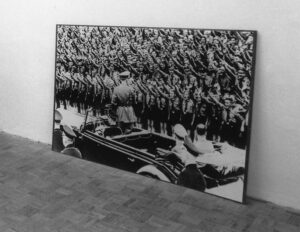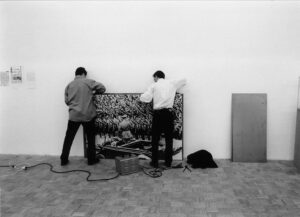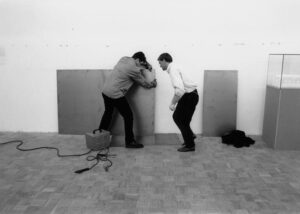Justin Hoffmann
in conversation with Michaela Melián
As far as I know, Gustav Metzger produced the work Hitler-Youth, Eingeschweißt for the first time on the occasion of his 1997 solo exhibition at Kunstraum München. (1) It is part of the series Historic Photographs, for which Metzger covered up photographs that predominantly depicted situations of war or fascism. Hitler-Youth, Eingeschweißt was one of the first works from this series, perhaps even the very first. It is the only work for which a photograph was sealed in.



The installation of Gustav Metzger. Historic Photographs: Hitler-Youth. Eingeschweißt at Kunstraum München, Munich, 1997. Photo: Pia Lanzinger
I flew from Munich to London three times to prepare the exhibition Gustav Metzger and met him there several times for lengthy conversations. Already at our first meeting in 1995, he was planning this project for the exhibition. On the 19th of August 1997, just a month before the opening, he sent me a fax with exact instructions for the works he wanted to show at this first retrospective in Germany.
One of the works described in this fax is Historic Photographs: Hitler-Youth, Eingeschweißt about which he had the following typewritten comment: This is a proposal for a work in the series Historic Photographs. A photo of H. at the Nürnberg Rally (I do not at present have the date) in front of 200 uniformed people. The plan is to put this onto a steel or iron sheet. Another sheet of exactly the same size and material is then in front, and the two sheets are welded together all round the edges. The sheets are 1 m, 80 cm wide, the height is less. As we discussed, the two pieces could be welded at the opening of the show. The people in front will need cheap dark spectacles.
It is the only time that he planned this action as a public performance, and it describes exactly how we proceeded at the opening. He kept in mind the audience attending the opening. They were to be given dark safety glasses.
There is an additional handwritten note on the fax. The project is going forward: Have just talked with Roland Seiler and will ring again at 3 pm on Friday. This means he was also in talks over the phone with the welder. Roland Seiler was head of the metal workshop of the Akademie der Bildenden Künste München and was given instructions by Gustav Metzger personally.
I believe he found this photograph in a historical book on national-socialist Germany in a London archive. Whether he intentionally cropped it to this specific section, I do not know. He sent me the negative by post. The size of the work was passed on to me and decided by him, I presume that it depended on the availability of large-sized sheets of steel. It mattered most to him that the size of the sheet reproduced the proportions of the photograph and that the work could be made as large as possible. The welded sheet stands on the floor and leans against the wall. It’s like an image that has enormous weight and makes an impression already solely for reasons of its materiality. He always required several people to carry the piece.
Our pathways for communication implied either me travelling to him to London or phone calls. In addition, he faxed long explanations and letters. We racked up a gigantic bill in phone and fax costs, about 700 DM. Some things he also sent to me in the post.
This exhibition in Munich was his first institutional solo exhibition in Germany. There were smaller exhibitions in London that preceded it, for instance in a library. Astrid Bowron from the Oxford Museum of Modern Art came to the opening, and a year later an exhibition followed there.
The exhibition at Kunstraum showed a lot of draft models. Some of the works existed and were sent in the post. The models had the purpose of visualising his ideas, though not all of them were realised. Some models were produced in Munich for the first time. Historic Photographs: Hitler-Youth, Eingeschweißt is one of those. Up to this day, the sheet remains in the archive of Kunstraum München. Metzger did not want to have the work transported back to London. The work was produced once more in the same size later and displayed in the comprehensive exhibition Gustav Metzger, Geschichte Geschichte at the Generali Foundation in Wien in 2005, among others.
When he sent me the fax on the 19th of August 1997, he still intended to travel to the opening of the exhibition. The welding of Hitler-Youth, Eingeschweißt was to occur publicly at the opening on the 11th of September. But reports of a rally of 5000 Neonazis who had come to Munich to protest the Wehrmachtsausstellung began to circulate internationally. Thoroughly shaken by these reports, he decided to cancel his trip to Munich. He thus sadly never saw his own exhibition. What happened in Germany, what was being discussed, was always of great interest to him. And that is why he knew about this Neonazi rally, the largest since 1945.
My first interviews with him, which I conducted in 1989, circled the topic of my dissertation, destruction art [Destruktionskunst] (2). I met him in 1989 for the interviews in Darmstadt, where he was doing research on Fluxus in the archives. We spoke German, and one could hear that Gustav Metzger spoke without any accent and articulated himself as if in print. It was tremendously impressive that he had not lost his German despite being forced to leave the country at twelve years of age due to Nazi persecution. He never mentioned to me whether he was in contact with any other German speakers in London. There was only his brother Mendel who had been dispatched to London with him on one of the Kindertransporte in January 1939. Gustav Metzger later came to Germany with some frequency but not to Nuremberg or Munich.
(1)
For more information on the exhibitions Gustav Metzger (11.09.–15.11.1997) and Gustav Metzger Revisited (27.01.–06.03.2022) respectively, both of which took place at Kunstraum München, see https://digitalisate.kunstraum-muenchen.de/artefakt/80Gustav Metzger 1997 for the first and https://artviewer.org/gustav-metzger-at-kunstraum-munchen/ [Retrieved 20.06.2025] for the second.
(2)
Justin Hoffmann, Destruktionskunst. Der Zerstörungsmythos in der Kunst der frühen sechziger Jahre, Munich 1995
Justin Hoffmann, curator of the 1997 Munich exhibition Gustav Metzger, in conversation with the artist Michaela Melián, 18th of January 2024